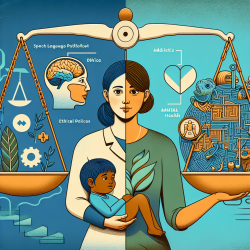In the field of speech-language pathology, particularly when working with deaf children, the importance of early language exposure cannot be overstated. Recent research published in PLoS ONE, titled "Early visual language skills affect the trajectory of literacy gains over a three-year period of time for preschool aged deaf children who experience signing in the home," sheds light on how early visual language skills, specifically American Sign Language (ASL), impact literacy development in preschool-aged deaf children.
This study, which involved a subset of data from a national longitudinal investigation, followed 56 preschool-aged deaf children over three years. These children were between the ages of three and six at the start of the study and were raised in homes where signing was a regular means of communication. The primary focus was to examine the growth trajectories in letter and word identification skills and to understand how factors such as having deaf parents and ASL skills influenced these trajectories.
The key findings of the study are as follows:
- ASL Skills Matter: The study found that stronger ASL skills were significantly associated with both higher levels of emergent print literacy and steeper rates of growth in literacy skills over time. This was true regardless of whether the children had deaf parents.
- Deaf Parents and ASL Skills: While having a deaf parent initially appeared to impact literacy outcomes, this effect became nonsignificant when ASL skills were taken into account. This suggests that the benefits of having a deaf parent are largely due to the early and consistent exposure to ASL.
- Variability in Outcomes: There was considerable variability in literacy outcomes among the children, with some demonstrating significant gains while others showed more limited progress. This variability underscores the importance of individualized educational approaches and further research into the factors that support optimal literacy development.
For practitioners, these findings emphasize the critical role of early and robust ASL exposure in supporting literacy development in deaf children. Here are some actionable steps to implement these insights in practice:
- Promote Early ASL Exposure: Encourage families to use ASL from an early age, providing resources and support to ensure consistent and accurate language modeling.
- Integrate ASL in Educational Settings: Ensure that educational programs for deaf children incorporate ASL as a core component of the curriculum, supporting both language and literacy development.
- Provide ASL Training for Parents: Offer training programs for hearing parents to develop their ASL skills, enabling them to provide a rich language environment at home.
- Conduct Further Research: Encourage ongoing research to explore the specific mechanisms through which ASL supports literacy development and to identify best practices for different subgroups of deaf children.
In conclusion, early visual language skills, particularly in the form of ASL, play a pivotal role in the literacy development of preschool-aged deaf children. By promoting early ASL exposure and integrating it into educational and home environments, practitioners can significantly enhance the literacy outcomes for these children.
To read the original research paper, please follow this link: Early visual language skills affect the trajectory of literacy gains over a three-year period of time for preschool aged deaf children who experience signing in the home.










